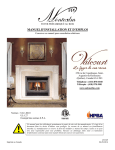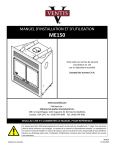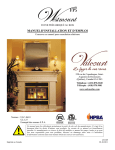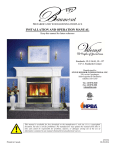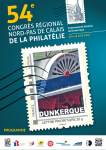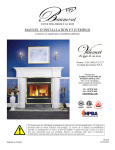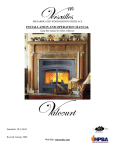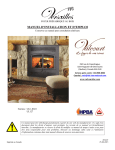Download Valcourt FP6 Specifications
Transcript
PREFABRICATED WOOD-BURNING FIREPLACE INSTALLATION AND OPERATION MANUAL Keep this manual for future reference 250, de Copenhague, SaintAugustin-de-Desmaures (Quebec), Canada G3A 2H3 Tel: (418) 878-3040 Fax: (418) 878-3001 www.valcourtinc.com Standards: ULC-S610 UL-127 E.P.A. Standards Exempt This manual is available for free download on the manufacturer’s web site. It is a copyrighted document. Re-sale is strictly prohibited. The manufacturer may update this manual from time to time and cannot be responsible for problems, injuries, or damages arising out of the use of information contained in any manual obtained from unauthorized sources. Printed in Canada 45336A 04-09-2014 THANK YOU FOR CHOOSING THIS VALCOURT FIREPLACE As one of North America’s largest and most respected wood stove and fireplace manufacturers, VALCOURT takes pride in the quality and performance of all its products. We want to help you get maximum satisfaction as you use this product. In the pages that follow you will find general advice on wood heating, detailed instructions for safe and effective installation, and guidance on how to get the best performance from this fireplace as you build and maintain fires, and maintain your wood heating system. Congratulations on making a wise purchase. Read this entire manual before you install and use your new fireplace. It is important that you follow the installations guidelines exactly. Failure to install this fireplace correctly could result in a house fire, bodily injury or even death. You may need to obtain a building permit for the installation of this fireplace and the chimney that it is connected to. Consult your municipal building or fire department about installation requirements in your area. We recommend that you also inform your home insurance company to find out if the installation will affect your policy. REGISTER YOU WARRANTY ONLINE To receive full warranty coverage, you will need to show evidence of the date you purchased your unit. Keep your sales invoice. We also recommend that you register your warranty online at www.valcourtinc.com/warranty-registration.aspx Registering your warranty online will help us track rapidly the information we need on your unit. PLEASE NOTE THAT THE PICTURES SHOWN IN THIS MANUAL ARE GENERIC AND MAY NOT MATCH EXACTLY THE LOOK OF YOUR FIREPLACE. CAUTION: DO NOT ATTEMPT TO MODIFY OR ALTER THE CONSTRUCTION OF THE FIREPLACE OR ITS COMPONENTS. ANY MODIFICATION OR ALTERATION OF CONSTRUCTION MAY VOID THE WARRANTY, LISTINGS AND APPROVALS OF THIS SYSTEM. IN THAT CASE, STOVE BUILDER INTERNATIONAL (SBI) WILL NOT BE RESPONSIBLE FOR DAMAGES. INSTALL THE FIREPLACE ONLY AS DESCRIBED IN THESE INSTRUCTIONS. 2 TABLE OF CONTENTS Page INTRODUCTION .......................................................................................................................... 4 INSTALLATION ........................................................................................................................... 5 Fireplace Installation ................................................................................................................... 7 Chimney Installation ................................................................................................................. 10 Installation Instruction for Masonry Application ..................................................................... 10 Fireplace Finish ......................................................................................................................... 17 USE AND SAFETY..................................................................................................................... 21 Creosote .................................................................................................................................... 22 Chimney Fire Safety Procedures .............................................................................................. 22 MAINTENANCE ......................................................................................................................... 22 Replacing Glass ........................................................................................................................ 23 Replacing Firestone in a Montcalm Fireplace .......................................................................... 23 TROUBLESHOOTING ............................................................................................................... 25 Exploded view for replacement parts ....................................................................................... 26 Parts list ..................................................................................................................................... 26 Views with measurements ........................................................................................................ 28 VALCOURT LIMITED LIFETIME WARRANTY ................................................................... 29 3 INTRODUCTION This manual contains all the information required for safe, efficient installation and use of your Valcourt fireplace. Read carefully all the instructions contained herein and keep this manual handy so you may refer to it whenever necessary. Before starting to install the fireplace, consult local authorities to obtain a construction permit and learn about all applicable regulatory requirements. Do not install this fireplace in a mobile home. Figure #1: Montcalm Fireplace Overview FP6 Montcalm Wood Fireplace Specifications Fuel Type Test Standards (safety) Test Standards (emissions) Shipping Weight Maximum Log Length recommended Flue Outlet Diameter: Cordwood ULC S610 and UL 127 E.P.A. Standards Exempt 370 lb (168 kg) 16” east-west 7” (178 mm) diameter (vertical) 4 INSTALLATION This fireplace is designed and approved for installation with the following brands of chimneys measuring 7” (178 mm) in diameter as well as a minimum of 15’ (4.6 m) and maximum of 45’ (13.5 m) in height. CHIMNEY MANUFACTURER Selkirk Selkirk Selkirk Selkirk Selkirk Selkirk Selkirk Selkirk Selkirk Security Chimney Security Chimney Simpson Dura Vent Simpson Dura Vent Simpson Dura Vent ICC Metal Fab American Metal American Metal Olympia Chimney FMI (U.S.A. only) BRAND TYPE Ultra-Temp (UT) Super Pro (SPR) Super Vent (JSC) Hart & Cooley (TLC) Sure-Temp (ST) CF Sentinel (CF) Super Pro 2100 (ALT) Super Vent 2100 (JM) UltimateOne ASHT+ S-2100 + Dura Tech Dura Plus HTC Dura Plus Excel 2100 Temp Guard HSS HS Ventis AC 1” Solid Pack 1” Solid Pack 1” Solid Pack 1” Solid Pack 1” Solid Pack 2” Solid Pack 2” Solid Pack 2” Solid Pack 1” Solid Pack 1” Solid Pack 2” Solid Pack 1” Solid Pack 2” Solid Pack AC Triple Wall 1” Solid Pack 1” Solid Pack AC Triple Wall AC Triple Wall 1” Solid Pack AC Triple Wall INNER DIAMETER 7" (178 mm) 7" (178 mm) 7" (178 mm) 7" (178 mm) 7" (178 mm) 7" (178 mm) 7" (178 mm) 7" (178 mm) 7" (178 mm) 7" (178 mm) 7" (178 mm) 7" (178 mm) 7" (178 mm) 7" (178 mm) 7" (178 mm) 7" (178 mm) 7" (178 mm) 7" (178 mm) 7" (178 mm) 7" (178 mm) We recommend that our woodburning hearth products be installed and serviced by professionals who are certified in the United States by NFI (National Fireplace Institute®) or in Canada by WETT (Wood Energy Technical Training) or in Quebec by APC (Association des Professionnels du Chauffage). Install the fireplace strictly according to the methods described herein and ensure proper clearance is provided between the walls. Use only the parts and chimneys specified in this manual. Any non-compliance with these directions could create a hazardous situation, thus voiding the certification and the warranty. ATTENTION: Do not modify or adapt the fireplace’s construction or components. This would void the warranty. In this event, VALCOURT FIREPLACES INC. would not be held responsible for any damages which may occur. No other device must be added to the chimney connected to the fireplace. Choose the best location for your fireplace based on the position of the doors and windows. Provide for the positioning of the outside air inlet as well as the chimney. Remember to leave sufficient space for the hearth extension and mantel. If possible, install the fireplace where it will not be necessary to cut any floor or ceiling joists. For optimal performance, install the chimney indoors if possible. In areas where temperatures are consistently below freezing (32ºF/0ºC), installing the chimney outdoors promotes functional problems such as insufficient draw, excessive creosoting, and difficult fire ignition. In addition, outdoor chimneys are subject to decreases in 5 pressure and smoke flow reversal. Fireplaces with outdoor chimneys installed on lower floors (basements) are particularly prone to smoke flow reversal. As for the chimney’s configuration, there are several possibilities. See Figure #3 to determine the appropriate configuration for your home. The straighter the chimney, the easier it will be to clean and maintain. Figure #2: Various Fireplace Locations 6 Figure #3: Chimney Configuration Figure #4: Fireplace Frame The table below shows the minimum chimney height requirements, fireplace included, according to the number of elbows: Chimney Number of Elbows Minimum Height Straight installation --------------- 15’ (4.6 m) 1 - 15° offset 2 - 15° elbows 15’ (4.6 m) 2 - 15° offsets 4 - 15° elbows 18’ (5.5 m) 1 - 30° offset 2 - 30° elbows 15’ (4.6 m) 2 - 30° offsets 4 - 30° elbows 20’ (6.1 m) * 1 - 45° offset * 2 - 45° elbows 16’ (4.9 m) * 2 - 45° offsets * 4 - 45° elbows 23’ (7.0 m) * Permitted only in Canada. FIREPLACE INSTALLATION 1. Before beginning installation, remove the fireplace trim to protect it from damage. The fastening screws are located behind the upper and lower louvers. Make sure no masonry products or acids come into contact with the trim as these may discolor the finish which is not under warranty. 2. Remove all combustible floor coverings, e.g. carpeting, linoleum, etc., from the area where the fireplace is to be installed. 7 3. The fireplace can be installed directly on the floor or on a platform made of combustible materials, such as wood or plywood or any other hard, sturdy surface. 4. A 48” x 16” (1220 mm x 407 mm) minimum hearth extension made of non combustible material is required. The extension can be installed below the base of the fireplace or flush mounted. (Figures #5) 5. To prevent any burning embers falling between the fireplace and the hearth extension from coming into contact with the floor, insert a metal sheet under the front of the fireplace. This sheet must extend 4” (100 mm) on both sides of the fireplace and 2” (50 mm) in front. The non combustible hearth extension should rest on the 2” (50 mm) band of sheet metal in front. You can also prevent embers from falling in the joint between the fireplace and the hearth extension by filling it with mortar grout. (Figure #5) 6. To anchor the fireplace to the floor, unfold the lower metal attachments and screw them to the floor using 1” (25 mm) screws. 7. The opening must be at least 24” (610 mm) away from any wall at a right angle with the appliance’s face. (Figure #11) 8. Place the appliance in the desired location. It must directly abut against the finished wall and not insulation or a vapor barrier. Do not add any insulation. 9. The standards in your area may require an outside air inlet. Even if such is not the case, it is beneficial to do so since this will improve the fireplace’s performance. Install a flexible air duct that is 4” (102mm) in diameter and a maximum length of 20’ (6.1 m). If a longer duct is required, increase diameter to 6” (152 mm) but maximum length will then be 40’ (12.2 m). The outside air intake must not come from a garage, carport, basement, attic or the chimney’s enclosure. 10. Install the outside air inlet in a place where it is unlikely to become blocked by snow and is sheltered from high winds. Make sure it is far from the gas meter or any other device that may emit fumes or gases, such as automobile exhaust. 11. Once you have decided on the location of the outside air inlet, drill a 4¼” (108 mm) hole in the wall. Insert the inlet grill in the hole from the outside and screw it to the wall with four 1” (25 mm) screws. 12. From the inside, insert the insulated flexible duct and attach it to the inlet grill with aluminum duct tape or ¾” (19 mm) metal screws. 13. On the lower left side of the fireplace, remove the metal piece blocking the air intake. Cut the insulating wool, insert the adaptor included with the fireplace and screw it in place using two ¾” (19 mm) metal screws. Using an adjustable collar or aluminum duct tape, attach the flexible duct to the adaptor. You can also install a decorative gas appliance in the hearth. To do this, install an automatic shut-off valve. Comply with ANSI Z21.60 (1991) standards governing “Decorative Gas Appliances” in vented fireplaces and ANSI Z233.1 with regards to the National Gas Code. ATTENTION: ALWAYS OPEN THE CHIMNEY DAMPER TO ITS MAXIMUM POSITION WHEN USING A DECORATIVE GAS APPLIANCE. THIS FIREPLACE HAS NOT BEEN TESTED WITH AN UNVENTED GAS LOG APPLIANCE. TO REDUCE THE RISK OF FIRE OR INJURY, DO NOT INSTALL A GAS LOG APPLIANCE WITHOUT A VENT PIPE. 8 Figure #5: Hearth Extension Installation 9 CHIMNEY INSTALLATION 1. Assemble the first chimney section with the adaptor (provided by the chimney manufacturer) using three ¾” (19 mm) screws. 2. Screw this assembly to the fireplace using four ¾” (19 mm) screws, taking care not to block the rotation of the flue damper key. 3. Continue the installation as per the instructions in the chimney manufacturer’s manual. (Figures #7, #8, #9 and #10) 4. Provide a 2” (51 mm) clearance between the chimney and any combustible material. To prevent overheating, never obstruct this clearance nor fill it with insulation or any combustible material. (Figure #12) 5. The chimney must rise at least 3’ (914 mm) over its juncture with the roof (Figure #6.1) and exceed by at least 2’ (610 mm) any wall, roof or building located within a radius of 10’ (3 m). Any length of chimney exceeding the roof by 5’ (1.5 m) or more, must be braced using tie rods or guy wires. 6. To limit creosoting, it is strongly recommended that an empty enclosure space be left between the chimney stack and the outer framing of the chimney. Make sure that at all points a minimum clearance of 2” (51 mm) separates the chimney and any combustible materials. NOTE: Since May 1997, whatever the type of fireplace or building, safety standards require that the fireplace and the full length of the chimney up to the ceiling be enclosed. (Figure #12) INSTALLATION INSTRUCTION FOR MASONRY APPLICATION WARNING: Before starting installation, the masonry chimney must be inspected by a qualified sweep. The following requirements must be respected: 1. The chimney must be absolutely clear of any soot residue or creosote. Check for cracks, loose or missing bricks that could inhibit correct installation of the liner. 2. The clearance to combustible must be a minimum of 1” between the outside of the masonry and any wood framing or loose insulation. 3. The chimney must be built in accordance with the current building code. 4. No other appliance can be connected to the same chimney. 5. The clearances to combustible for the BISPMA and BISUPMA30 connectors are 2” on the side and bottom and 16” at the top. 6. The connector parts are not necessary if the connection between the insulated length and the stainless steel liner is done within the masonry chimney. 10 INSTALLATION: The chimney must be relined with a stainless steel liner model Tubinox or Projet SS or any other listed liner or flexible liner to ULC-S635, ULC-S640 or UL777 of the same diameter as the outlet of the fireplace. For connection at 45 angle, a special connector (BISPMA for the 7 in. chimney) must be used to connect the liner to the insulated chimney. For connection at 30, use the BISPMA30 connectors. Follow these steps: 1. 2. 3. 4. 5. 6. 7. 8. Position the fireplace in its location. Temporarily install the ASHT+ elbow on the top of the fireplace and, using a level, mark with an oval the location where the flue liner will enter the masonry chimney. In the middle of the oval, drill a hole in the masonry chimney at 45 or 30. Increase the size of the hole until a 45 or 30 Tubinox liner elbow can be easily slipped through. Slide the liner down from the top of the masonry chimney until you reach the hole level. Slip through the hole a 45 or 30 liner elbow and connect it to the liner. Add a small liner section to the liner elbow which will allow the liner to extend at least 12” (measured at the top of the liner) from the masonry chimney. Seal the opening around the liner with high temperature refractory cement. The next steps must be done in the following order: 8.1 Select the ASHT+ length that will fit between the elbow and the liner so that it will slide at least 2” over the liner section. (You may need to cut the liner for a better fit.) 8.2 Take that section and the BISPMA (BISPMA30) cover and slide it over the line. Make sure you have enough opening to be able to install the ASHT+ elbow without difficulty. 8.3 Install the 45 or 30 elbow on the fireplace. 8.4 Slide the length section back down on the elbow and twist lock the two together. 8.5 Pull the cover down over the length and install the insulation pad over the liner; be careful to cover the liner completely. 8.6 Slide back the cover over the insulation and fix it in place using the 3 screws supplied. 11 Figure #6: Installation Security Chimney Adaptor Masonry Chimney 12 Figure #6.1: Minimum Chimney Height Installation with an 7 in. EXCEL chimney Installing your fireplace with a masonry chimney still requires using EXCEL chimney from the top of the fireplace to the wall where it will connect to a listed liner that will run up inside the masonry chimney. The stainless steel liner should be fitted inside the clay liner all the way to the top of the masonry chimney. It is not meant to replace the clay liner. You can use either the EXCEL liner or any other listed liner or flexible liner to ULC-S635, ULC-S640 or UL777. Special care is to be taken to make sure that you have a good solid connection between the EXCEL chimney and the liner. A masonry adaptor (FO-FDM7) was designed specially for that purpose and is available from your RSF dealer. It will attach to the liner with 3 stainless rivets (provided) and to the EXCEL chimney with 3 screws (provided). After mortaring in place, the connection between the EXCEL chimney and the liner should not be visible in order to isolate the heat released through the liner from the fireplace enclosure. You must install at least one 18” length of EXCEL chimney after the EXCEL chimney elbow. The uppermost part of the excel chimney- where it enters the masonry chimney – must be a minimum of 12” from the ceiling. NOTE: If the ceiling is high enough, you can install one or more EXCEL chimney lengths directly on the fireplace before the elbow. To make the hole through the masonry chimney and make the connection to the fireplace, we recommend that you follow these steps: 1. Sight-in and mark the outline of where the EXCEL chimney will penetrate the masonry chimney. 2. Using a large (3/4”-2”) masonry drill bit, drill a hole exactly in the center of the oval outline. With a masonry hammer and drill, slowly enlarge the hole to the size required. Remember to work from the center out. Be especially careful with the clay liner behind the brick because three sides of it must stay in place. 13 3. You will need enough room to secure an elbow to it with at least two screws. If it difficult to install rigid stainless steel liner in the existing masonry chimney or for a masonry chimney with less than 10” x 10” inside, a listed stainless steel flexible liner can be used along with a flexible/rigid adaptor (LM-LAF) available from your ICC dealer. 4. Install the liner elbow and masonry adaptor on the lower end of the liner. 5. Move the fireplace forward enough to install the EXCEL chimney on the fireplace (elbow and length) then move the fireplace back into position as you connect the masonry adaptor to the EXCEL chimney. NOTE: The stainless steel flexible liner must be installed inside the clay liner. It is not meant to replace the clay liner. Installation with EXCEL chimney 14 Figure #7: Straight Chimney Installation Figure #8: Chimney with Elbows Installation 15 Figure #9: Exterior Chimney Installation Figure #10: Isolated Chase Installation 16 FIREPLACE FINISH 1. Combustible materials can be used to finish the fireplace. The framing can be built directly on the sides of the appliance. (Figure #11) 2. Side walls can exceed the appliance’s face by a maximum of 6” (152 mm). (Figure #11) 3. Adjoining walls may also be built at a 458 angle from the edge of the face. However, any right angle wall must be located at least 24” (610 mm) away from the fireplace opening. (Figure #11) 4. Combustible framing can cover the sides or the back of the appliance but not its face. (Figure #14) 5. To enclose the top of the finish, it must reach at least 84” (2133 mm) in height from the base of the fireplace. Do not insert insulation in the chimney enclosure. (Figure #12) 6. It is possible to enclose the top and sides of the appliance but a minimum clearance of 2” (51 mm) must be provided around the chimney. (Figure #12) 6.1 In the U.S., it is not permitted to enclose the top of fireplace appliances. (Figure #12) 7. If the mantel is made of combustible materials, it must be installed at a height of at least 46” (1169 mm) from the base of the fireplace. (Figure #13) 8. The fireplace’s facing must be made of non-combustible materials only. Fireplace Facing 8.1 Remove the decorative trim. 8.2 Install the non-combustible facing material (marble, ceramic tile, Durock, brick, etc.). 8.3 Reinstall the decorative trim. (Figure #14) NOTE: Make sure nothing obstructs or interferes with the front hot air outlets. The enclosure could overheat. Any accessible chimney must be fenced off or finished to prevent contact. Figure #11: Fireplace Finishing 17 Figure #12: Chimney Enclosure 18 Figure #13: Mantel Positioning 19 Figure #14: Installation of Fireplace Facing 20 USE AND SAFETY 1. Teach children fireplace safety rules. 2. Do not use the fireplace under the following conditions: 2.1 Whenever a firestone is missing or broken. 2.2 Whenever the ceramic glass is cracked or broken. 3. Never use flammable liquids to light or revive a fire and keep such products away from any heat source. Before lighting a fire, make sure there are no flammable liquids, gases or fumes in the room. 4. Before starting each fire, open the flue damper using the key located in the middle behind the upper louver. When the fireplace is hot, do not touch the damper key with your bare hands. 5. Open the air intake lever located on the left behind the lower louver. 6. Prevent smoke flow reversal by preheating the chimney flue. Just hold a torch made of rolled up newspaper towards the smoke chamber for a few minutes. 7. Valcourt fireplaces are designed to burn reasonable quantities of wood. Avoid making overly intense fires that would damage the appliance. DO NOT OVERHEAT 8. Use the log support made by VALCOURT FIREPLACES INC. Burn only the quantity of combustible it can contain. Do not burn garbage, painted wood or wood that has been exposed to salt water. 9. Always have minimum of 1” accumulation of ashes at the bottom of the fireplace. The grate may deform if no ashes are left. 10. When using the fireplace for the first times, make small fires to give the firestone time to dry properly. The appearance of fine cracks in the firestone is normal and therefore not hazardous. It is not a matter for concern. 11. During the first fires, you may detect a certain odor and the coating and oil protecting certain appliance parts may smoke a little. If you open a window, these will quickly dispel. 12. It could also become necessary to open a window if the house is too airtight or if a fan is running. 13. Keep the firescreen closed at all times. You must not leave the fireplace lit under no surveillance. Do not close the doors during fire. The glass must be allowed to warm slowly and closed on low fires. (Glass is not warranty.) 14. Expansion and contraction noises during the heating and cooling cycle are normal. It is not a matter for concern. 15. Once the fire is out and the embers have cooled, close the flue and the air intake dampers until you prepare to light the next fire. NOTE: Make sure furniture, draperies, and any extra logs are at lease 48” (1220 mm) away from the fireplace. 21 CREOSOTE When wood burns slowly, it produces tar and other organic vapors which combines with humidity to produce creosote. Creosote vapor condenses in the chimney left relatively cool by the slow fire and coats the inside of the flue with residue. When creosote ignites, it produces a red-hot, extremely dangerous fire. It is therefore recommended to make small, brightly burning fires rather than lazy, smoldering fires. Not only will it keep your glass doors and flue cleaner but, what is most important, it will lessen the likelihood of chimney fires. CHIMNEY FIRE SAFETY PROCEDURES What to do if you suspect a chimney fire has started: 1. Close the fireplace doors. 2. Alert everyone in the house. 3. Call the Fire Department if necessary. 4. Put out the fire in the fireplace with a dry-chemical extinguisher, baking soda, sand or ashes. (Never use salt because it is corrosive, nor water because it could cause a steam explosion.) 5. Make sure the sparks coming from the chimney do not set fire to the roof. 6. Before reusing the fireplace, have it inspected by the Fire Department. MAINTENANCE 1. Clean color trim with soapy water and a soft cloth. Do not use any metal polish or abrasives. 2. Keep the glass relatively clean. Dirty windows will make the fireplace overheat. Wait until the glass is cool before attempting to clean it. Wash the glass with window or oven cleaner, dishwashing liquid or just soap and water. Spray the cleaner on a soft cloth and not on the glass, since overspray may discolor coating or metal plating (not covered by the warranty). DO NOT use steel wool, soap pads (S.O.S.) or any other abrasive product since these may scratch the glass. 3. To remove the ashes, lift the log support. Put the ashes in a metal container with an airtight lid. Place the container on a non-combustible surface away from any flammables until the ashes are cold. 4. Before each heating season, inspect the interior and exterior of the fireplace and chimney for any defects or deterioration. 5. To reduce the risk of chimney fires, keep it relatively clean and regularly check for creosote buildup. To open the rain cap, just unscrew it counter-clockwise. Any layer of creosote greater than 1/8” (3 mm) thick should be swept. Use a plastic brush to avoid scratching the flue. 22 REPLACING GLASS Do not use the fireplace with a cracked glass. 1. Cut the silicone joint holding the broken glass to the frame. 2. Remove all debris from the frame. 3. Use only 3/16” (5 mm) tempered glass. 4. Slide the new window into the frame and fasten it in place with temperature-resistant silicone. 5. Handle the glass with care to avoid injury. 6. Allow to dry for 24 hours. NOTE: Never use substitute parts. Use only Valcourt brand parts. REPLACING FIRESTONE IN A MONTCALM FIREPLACE Do not use the fireplace with a broken or missing firestone. 1. 2. 3. 4. 5. 6. 7. 8. Remove the front stone (VA2-071-5). Remove the upper deflector (VA2-004A) holding the side wall stones in place. Remove the log support by pulling on it until it comes free. Remove the floor stone (VA2-071-4). Remove one of the side wall stones (VA2-71-3 or VA2-071-2). Remove the second side wall stone while holding the back stone in place (VA2-071-1). Remove the back stone (VA2-071-1). To reinstall the replacement firestones, just follow the steps in reverse. 23 Figure #15: Replacing Montcalm Firestones 24 TROUBLESHOOTING Expansion and contraction noises during the heating and cooling cycle are normal. Here is how to prevent smoke flow reversal: position air intake lever to maximum, slowly open the fireplace doors before lighting the kindling, make a torch by lighting rolled up newspaper and hold it out to the smoke chamber until your feel the chimney begin to draw. A properly installed Montcalm Fireplace should never smoke. If it does, it will probably be for one of the following reasons: 1. The chimney’s outdoor installation is defective or incorrect, creating draught reversal problems and, consequently, making it difficult to start a fire. 2. The chimney was not adequately preheated. Remember that the hotter the fireplace, the better the chimney draws smoke. 3. The fireplace doors or the air intake damper were closed too quickly. Adequate air supply is essential to sustaining combustion. 4. If the room is too airtight or negative pressure has built in the house and there is no outside air intake, air supply to the fireplace will be lower than usual. Temporarily open a window near the fireplace to increase air supply. 5. Any type of fan (range hood or bathroom exhaust fan) that draws air outside can create negative pressure. Shut off the fan and/or open a window near the fireplace to solve this problem. 6. Wet wood smokes more than dry wood. The damper the wood, the less heat it generates and the more creosote it produces. If the wood being burned is very damp, inspect the chimney every month it is used. 7. Make sure the chimney is reasonably clean and unobstructed. 8. Check whether the chimney is the recommended height: minimum of 3’ (914 mm) from the roof joint. If not, add more lengths of flue. This will improve draw and reduce the fireplace’s tendency to smoke. 9. Fireplaces with chimneys abutting an unfinished outside wall often tend to smoke and are difficult to light. To prevent these problems, open a window near the fireplace and preheat the chimney by holding a newspaper torch in the smoke chamber (upper part of the combustion chamber). Wait long enough to establish effective draw, then light the fire. 10. Always remove excess ashes before lighting a fire. Maintaining a 1” (2.5 mm) thickness of ashes optimizes combustion and maximizes fire duration. 11. Use only dry wood, i.e. wood that has dried for one year (15% to 20% humidity). Very dry wood will burn very well, but will generate a great deal of heat and will not last. 25 EXPLODED VIEW FOR REPLACEMENT PARTS PAR TS LIS T 26 # 1 2 3 4 5 6 7 8 9 10 11 12 13 14 15 16 17 18 19 20 21 22 23 24 25 26 27 Part # SE60087 SE60090 AC09194 PL60760 30217 30244 VA2051J SE60093 SE60095 SE60063 30084 PL59815 PL59765 SE60079 30472 VA4400 44122 44085 44087 44080 45336 VA2071-3 VA2071-4 VA2071-5 VA2071-2 VA2070 VA2071-1 Description LEFT DOOR FRAME ASSEMBLY RIGHT DOOR FRAME ASSEMBLY BLACK WOODEN DOOR HANDLE (2 PER PACKAGE) DOOR RETAINER GLASS CUSHION WOOD SCREW #8 X 3/4" PAN HEAD CERAMIC GLASS 3/16" X 14 7/8" X 17 1/8" LH SIDE MECHE DOOR ASSEMBLY RH SIDE MECHE DOOR ASSEMBLY EXHAUST DAMPER ASSEMBLY EXHAUST DAMPER ROD 4'' AIR INTAKE ADAPTER BOTTOM OR TOP LOUVER ASSEMBLY SPRING 1/2'' OUTSIDE DIA. X 3'' LONG BLOWER ASSEMBLY DOUBLE CAGE BLOWER 150 CFM RHEOSTAT KNOB RHEOSTAT NUT RHEOSTAT WITH NUT FP6 INSTRUCTION MANUAL RIGHT REFRACTORY SLAB FLOOR REFRACTORY SLAB FRONT REFRACTORY SLAB LEFT REFRACTORY SLAB CAST IRON GRATE REAR REFRACTORY SLAB 27 Qty 1 1 1 2 4 4 2 1 1 1 1 1 1 2 4 1 1 1 1 1 1 1 1 1 1 1 1 VIEWS WITH MEASUREMENTS 28 VALCOURT LIMITED LIFETIME WARRANTY The warranty of the manufacturer extends only to the original consumer purchaser and is not transferable. This warranty covers brand new products only, which have not been altered, modified nor repaired since shipment from factory. Products covered under this warranty must have been manufactured after the revision date indicated below. Proof of purchase (dated bill of sale), model name and serial number must be supplied when making any warranty claim to your VALCOURT dealer. This warranty applies to normal residential use only. Damages caused by misuse, abuse, improper installation, lack of maintenance, over firing, negligence or accident during transportation, power failures, downdrafts, or venting problems are not covered by this warranty. This warranty does not cover any scratch, corrosion, distortion, or discoloration. Any defect or damage caused by the use of unauthorized parts or others than original parts void this warranty. An authorized qualified technician must perform the installation in accordance with the instructions supplied with this product and all local and national building codes. Any service call related to an improper installation is not covered by this warranty. The manufacturer may require that defective products be returned or that digital pictures be provided to support the claim. Returned products are to be shipped prepaid to the manufacturer for investigation. If a product is found to be defective, the manufacturer will repair or replace such defect. Transportation fees to ship the product back to the purchaser will be paid by the manufacturer. Repair work covered by the warranty, executed at the purchaser’s domicile by an authorized qualified technician requires the prior approval of the manufacturer. Labour cost and repair work to the account of the manufacturer are based on predetermined rate schedule and must not exceed the wholesale price of the replacement part. All parts and labour costs covered by this warranty are limited according to the table below. The manufacturer at its discretion may decide to repair or replace any part or unit after inspection and investigation of the defect. The manufacturer may, at its discretion, fully discharge all obligations with respect to this warranty by refunding the wholesale price of any warranted but defective parts. The manufacturer shall in no event be responsible for any special, indirect, consequential damages of any nature, which are in excess of the original purchase price of the product. A one-time replacement limit applies to all parts benefiting from a lifetime coverage. This warranty applies to products purchased after October 1st, 2011. WARRANTY APPLICATION PARTS LABOUR DESCRIPTION Combustion chamber (welds only), castings, convector air-mate, ceramic glass (thermal breakage only*), and secondary air tubes*. Plating* (defective manufacture) – subject to limitations above. Stainless steel firebox components, surrounds and heat shields, ash drawer, steel legs, pedestal, trims (aluminum extrusions), C-Cast baffle*, and vermiculite baffle*. Carbon steel firebox components, glass retainers, and handle assembly. Blowers, heat sensors, switches, rheostat, wiring, and other controls. Paint (peeling), gaskets, insulation, refractory panels* and ceramic fibre blankets. *Pictures required Lifetime 4 years Lifetime n/a 5 years 3 years 3 years 2 years 2 years 1 year 1 year n/a Shall your unit or a components be defective, contact immediately your VALCOURT dealer. Prior to your call make sure you have the following information necessary to your warranty claim treatment: Your name, address and telephone number; Bill of sale and dealer’s name; Serial number and model name as indicated on the nameplate fixed to the back of your unit; Nature of the defect and any relevant information. Before shipping your unit or defective component to our plant, you must obtain from your VALCOURT dealer an Authorization Number. Any merchandise shipped to our plant without authorization will be refused automatically and returned to sender. 29





























